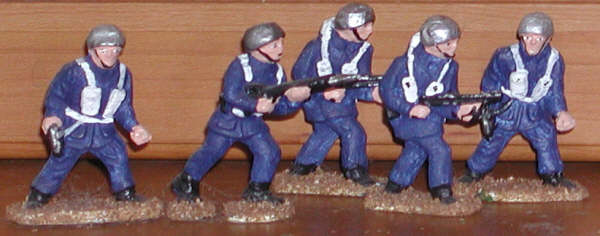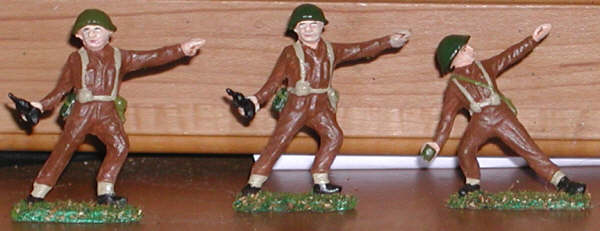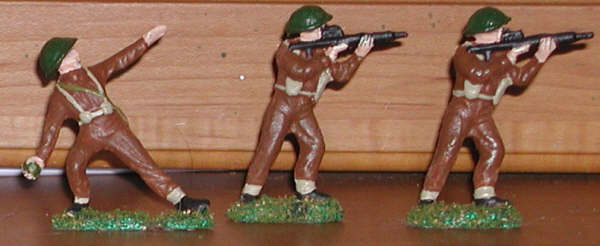
Copyright 2008 All Rights Reserved
More Color Tricks

You have seen what a little color can do to a set of soldiers. I have had a lot of fun pushing the envelope with this threesome of British paratroopers. My latest inspiration was winter camouflage. This particular set has been painted a basic off-white shade. I used Delta Ceramcoat's Oyster White for the uniforms. An olive shade was used for the webbed gear. Helmets were painted pure white. I supplemented the set with the American Binoculars Guy from another mold.
To get the feel of ice, I painted the bases a light turquoise blue. Then I gave them a wash or dry brushing of pure white. It looks cool. Shadows in snow are not black or grey, but pale blue. You have to get the feel of cold when you make a set of snow troops.

These are some of the "spy cadre" that we showed under "Berlin Grays and Spies." In popular spy movies, the spy headquarters frequently has a uniformed force of guards and technicians. They are common in the "James Bond" movies as well as various spy and science fiction tales.
This particular set has blue uniforms, black gear and white helmets. The helmets and uniform colors resemble the the "Air Police", the U.S. Air Force's military police. This kind of gear is impractical for combat in the field, but works well for police work on military installations and airfields.

This set of Spy Cadre has white gear and silver or polished steel helmets. Chromed helmets were used for parade duty by many military organizations. They would be issued to the color guard. Several toymakers painted their army men with silver helmets. I remember a set of 30mm soldiers by SAE that had green fatigues and silver helmets.
The silver helmet looks good, although it is impractical off the parade field. They have shown up on science fiction movies. They would definitely distinguish security personnel and cadre from an invading force. Can you see silver-helmeted guards at science fiction type installations?
Again, this was just another exercise in fun with paint. What matters here is that they look good.

Do you know whom these fellows are?
They are not the British Guardsmen at Buckingham Palace. Perhaps they look like the Coldstream Guard, but they are not British at all. This is the Livguard of Denmark. At first glance, they resemble the British guarsdsmen. A closer look gives the clue. British guardsmen wear black trousers and have white trim on the cuffs. These fellows have blue trousers with white stripes, and blue collars and cuffs.
Another set, this time from Castings' vulcanized rubber molds. The best I can gather is that they care copies of old Johillco or Cherilea guardsmen. Unlike modern guardsmen, these fellows could have been in combat. Back in the late 19th Century when soldiers like this were first cast, it was not unusual for troops to go to war in busbys, shakos and guardsman attire. Many a toy battle was fought with soldiers like this, long after the days of bright coats and white ammo pouches had passed.
Personally, I like the running rifleman. He is a real departure from the stylized marching and firing poses. And if you guessed these fellows are fun to cast and paint, you are right.

These brown figures are another turn of the paint brush. They are similar to the British infantry discussed under "Unique Troops." In fact, the only real difference is that their uniforms are brown rather than dark green.
British troops wore brown drab uniforms during World War II. Khaki field gear was common. Even the green field gear quickly faded to a khaki tan. I found out recently that I had been mistaken for years about British boots. I assumed they were brown. In fact, World War II British troops wore black boots. This is the first set where I got it right. British holsters were made of webbed material by World War II. The helmet was called a turtle shell. I think it must have been designed by Scots. Who else would think of putting turtle shells on their heads? The turtle shell helmet replaced the older trench helmet during the latter part of World War II. It stayed in use for many years.

The next trio has the item that exposes them as anachronisms. The automatic rifle was an experimental weapon of the 1950s. Many were certain the British Army would accept it, and a few toymakers jumped the gun by arming their next versions of army men with the "bullpup" rifle. Surprise! The army rejected the weapon, preferring instead to import a Belgian rifle. By the time they accepted a bullpup, the entire uniforms, webbed gear and helmet had changed.it.

Color can make a big difference for the Revolutionary War. The cut of clothing was pretty consistent, and military uniforms followed their current civilian fashions. These fellows came from a mold sold as a Revolutionary War U.S. Marine. A distinguishing feature of Marines was a brimmed rather than cocked hat. Other units also wore brimmed hats,. In fact, the brimmed hat was as common among civilians as the cocked hat, or tricorn. In militia units where "uniforms" were a relative thing, men wore whatever headgear they had.
A roll of the paint makes a handful of various figures. Here we have a British loyalist, a 3rd New York Regiment militiaman and a militiaman of the 3rd Pennsylvania battalion. You can crank out whole armies of Seven Years War and Revolutionary War with just one basic figure and a lot of different paint colors.
Contact Us at thortrains@comcast.net